Reducing damage to grain stores of the poor
December, 2004
Saving grain from hungry pests can significantly improve the food security and livelihoods of farm households in the developing world’s poorest areas.
Even if poor farmers have a good maize harvest, many who live in humid environments and do not have effective storage containers face significant grain losses in the following months. Grain can suffer 80% damage and 20% weight loss within six months after harvest in Mexico’s harsh tropical environments, where grain-damaging insects thrive, according to CIMMYT entomologist David Bergvinson. “Two major pests in Africa—maize weevil and larger grain borer—can consume as much as 15% of a harvest in a few months,” says Bergvinson. Working on reducing storage losses is one way that he and other CIMMYT scientists target impoverished areas, increasing food security and allowing farmers to enter grain markets when prices are favorable.
Participatory Breeding to Foil Weevils
There are several ways to lessen grain damage. Farmers can remove infested grain and thoroughly clean storage facilities to eliminate insects before storing new grain. Improved grain storage technologies, such as silos, also help. Finally, scientists can breed maize to be more insect resistant with tighter husks or harder kernels. “With resistance as an inherent part of seed, farmers can cut back on the use of noxious pesticides,” says Bergvinson.
Working to breed hardier maize, Bergvinson crossed farmers’ varieties in Mexico with insect-resistant and drought-tolerant CIMMYT varieties and returned the seed to farmers for planting in mid-2004. Researchers also planted these crosses on farms near CIMMYT research stations to evaluate their performance, to make controlled pollinations, and to compare farmers’ selections with their own. “Our ultimate goal is to increase the genetic diversity of landraces with resistance to production constraints identified by farmers,” says Bergvinson. Farmers most often asked for drought and weevil resistance to be added to their landraces.
Targeting Peaks of Poverty
Bergvinson and his associates are working with 54 farmer varieties for lowland tropical areas of Mexico and 36 for higher altitudes (1,200-1,800 meters above sea level). It is in many of these hill zones where poverty and maize-bean subsistence farming go hand in hand. The methods applied could have relevance for smallholder maize farmers in other parts of Latin America and in Africa.In preparation for extending their efforts to reach more of the poor, the researchers have also sampled farmer varieties in eight Mexican locations identified in a recent CIMMYT study (see Maps Unearth New Insights for Research to Help the Poor) as having a high concentration of the poor. “We’re working with farmers in these areas to improve their varieties for traits they identify, such as resistance to storage pests and, in hill zones, stronger roots and stems so that plants don’t fall over in strong winds,” Bergvinson says. The researchers are also taking care to maintain other traits that farmers value. One example in lowland areas is the long husks that farmers remove and sell as wrapping for the popular Mexican dish known as “tamales.” In some communities, husks for this purpose are worth more than the grain (see Rural Mexico and Free Trade: Coping with a Landscape of Change).
Global Science to Protect Grain
Bergvinson belongs to a worldwide community of researchers applying science at all levels to develop pest-resistant maize. “A small but noticeable renaissance in the use of resistant varieties to minimize storage losses is taking place worldwide, especially for ecologies where storage infrastructure doesn’t exist,” says Bergvinson. He says researchers have made significant progress in understanding the biochemical, biophysical, and genetic bases for resistance, among other things to ensure the traits satisfy consumer demands. Such traits are being “mapped” using DNA technology to confirm their role in resistance and to identify the genes involved. “The real potential of this technology will be felt in developing countries,” Bergvinson explains. “The resistance is packaged in the seed and designed to ensure that farmers have the option to recycle seed, a practice common to small-scale farmers.”
For more information: d.bergvinson@cgiar.org
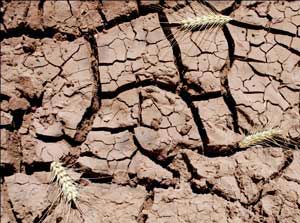 In a recent New York Times article, journalist Justin Gillis reports on the planet’s looming threat of climate change, agriculture’s monumental challenge, and how CIMMYT is working diligently to mitigate these global hurdles.
In a recent New York Times article, journalist Justin Gillis reports on the planet’s looming threat of climate change, agriculture’s monumental challenge, and how CIMMYT is working diligently to mitigate these global hurdles.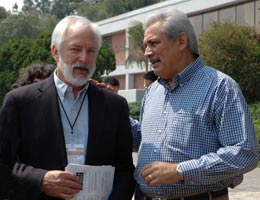 Skyrocketing food prices recently brought Latin American agriculture ministers from 14 countries and development experts to CIMMYT to seek a way forward for a region characterized by serious rural poverty.
Skyrocketing food prices recently brought Latin American agriculture ministers from 14 countries and development experts to CIMMYT to seek a way forward for a region characterized by serious rural poverty.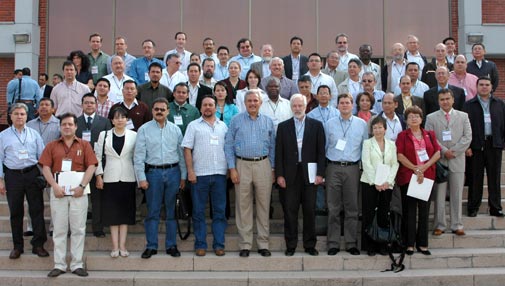
 Five undergraduate biology students from Truman State University in Kirksville, Missouri, visited CIMMYT headquarters for four days in August to learn about CIMMYT’s research and observe scientists working in an international environment.
Five undergraduate biology students from Truman State University in Kirksville, Missouri, visited CIMMYT headquarters for four days in August to learn about CIMMYT’s research and observe scientists working in an international environment.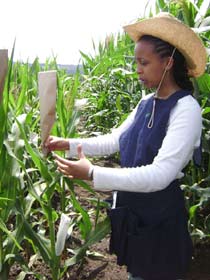 CIMMYT is adapting an advanced technology—the doubled haploid approach—to develop inbred lines of tropical maize for sub-Saharan Africa. It promises to reduce costs and speed the arrival of better-adapted maize for resource-poor farmers in the world’s toughest environments.
CIMMYT is adapting an advanced technology—the doubled haploid approach—to develop inbred lines of tropical maize for sub-Saharan Africa. It promises to reduce costs and speed the arrival of better-adapted maize for resource-poor farmers in the world’s toughest environments.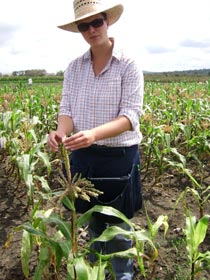
 Norman E. Borlaug, former CIMMYT wheat breeder, 1970 Nobel Peace Laureate, and scientist whose work helped spark the Green Revolution, was awarded the National Medal of Science by US President George W. Bush at a ceremony in the White House on 13 February 2006. The award was established in 1959 to recognize special achievements and outstanding contributions in the sciences.
Norman E. Borlaug, former CIMMYT wheat breeder, 1970 Nobel Peace Laureate, and scientist whose work helped spark the Green Revolution, was awarded the National Medal of Science by US President George W. Bush at a ceremony in the White House on 13 February 2006. The award was established in 1959 to recognize special achievements and outstanding contributions in the sciences.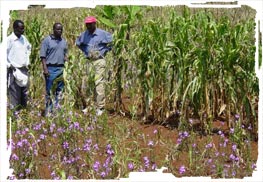 In a country where each person consumes at least 100 kilograms of maize a year, a new, easy-to-use, affordable practice that could raise the crop’s production by 200,000 tons is, naturally, greeted with much celebration in Kenya.
In a country where each person consumes at least 100 kilograms of maize a year, a new, easy-to-use, affordable practice that could raise the crop’s production by 200,000 tons is, naturally, greeted with much celebration in Kenya.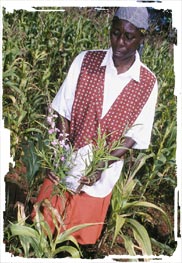
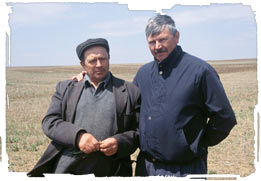 Kazakhstan and Siberia connect with CIMMYT to improve their wheat.
Kazakhstan and Siberia connect with CIMMYT to improve their wheat.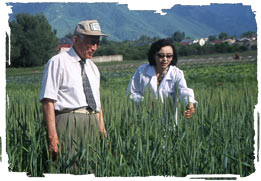 Illustrating the point, in 2000 northern Kazakhstan and Siberia suffered a leaf rust outbreak, Morgounov recounts. None of the 80 modern varieties and lines being tested showed resistance to the pathogen. This clearly indicated a pressing need for the breeders to address, and one for which CIMMYT was well equipped to assist.
Illustrating the point, in 2000 northern Kazakhstan and Siberia suffered a leaf rust outbreak, Morgounov recounts. None of the 80 modern varieties and lines being tested showed resistance to the pathogen. This clearly indicated a pressing need for the breeders to address, and one for which CIMMYT was well equipped to assist.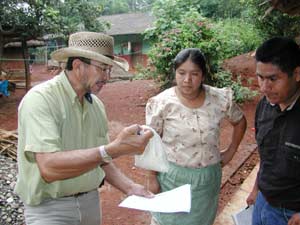 What role do farmers play in the evolution of maize diversity? How extensive are the farming networks and other social systems that influence gene flow? These and other questions are helping researchers to combine knowledge of the genetic behavior of plants with information on human behavior to understand the many factors that affect maize diversity.
What role do farmers play in the evolution of maize diversity? How extensive are the farming networks and other social systems that influence gene flow? These and other questions are helping researchers to combine knowledge of the genetic behavior of plants with information on human behavior to understand the many factors that affect maize diversity. The farmers visited by Flores and Ramírez in early June near Huatzalingo and Tlaxcoapan, Hidalgo are from just 2 of 20 study communities spanning ecologies from Mexico’s highlands down to the lowlands. Six months earlier, when farmers in these communities responded to researchers’ survey question, they asked some questions of their own: What does CIMMYT do? How can we get seed?
The farmers visited by Flores and Ramírez in early June near Huatzalingo and Tlaxcoapan, Hidalgo are from just 2 of 20 study communities spanning ecologies from Mexico’s highlands down to the lowlands. Six months earlier, when farmers in these communities responded to researchers’ survey question, they asked some questions of their own: What does CIMMYT do? How can we get seed?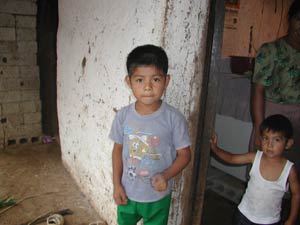 Farmers in the survey area of rural Hidalgo grow maize on the poorest, most steeply sloping land and struggle with soil diseases, low soil fertility, leaf diseases, low grain prices, and limited information about the use of chemical herbicides. Strong wind, rain, and hurricanes damage crops. Landslides cause erosion. Some farmers have access to roads and can transport their harvest by vehicle, but some farms located far from the communities have no highway access. The paths to farmers’ fields can be so narrow that not even cargo animals can maneuver on them with loads, so farmers must carry the harvest on their backs. Some walk 10 kilometers up and down slopes with heavy bags on their backs.
Farmers in the survey area of rural Hidalgo grow maize on the poorest, most steeply sloping land and struggle with soil diseases, low soil fertility, leaf diseases, low grain prices, and limited information about the use of chemical herbicides. Strong wind, rain, and hurricanes damage crops. Landslides cause erosion. Some farmers have access to roads and can transport their harvest by vehicle, but some farms located far from the communities have no highway access. The paths to farmers’ fields can be so narrow that not even cargo animals can maneuver on them with loads, so farmers must carry the harvest on their backs. Some walk 10 kilometers up and down slopes with heavy bags on their backs.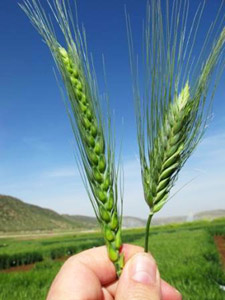 In order to contribute to world food security, the International Research Initiative for Wheat Improvement (IRIWI), supported by research organisations and funding agencies from about ten countries, has been adopted by the Ministers of Agriculture of the G20. INRA, with the Biotechnology and Biological Sciences Research Council (UK) and the International Maize and Wheat Improvement Center (CIMMYT, Mexico), will contribute to the coordination activities of the IRIWI during the first four years of the project.
In order to contribute to world food security, the International Research Initiative for Wheat Improvement (IRIWI), supported by research organisations and funding agencies from about ten countries, has been adopted by the Ministers of Agriculture of the G20. INRA, with the Biotechnology and Biological Sciences Research Council (UK) and the International Maize and Wheat Improvement Center (CIMMYT, Mexico), will contribute to the coordination activities of the IRIWI during the first four years of the project.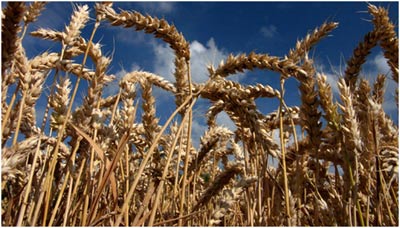
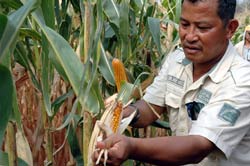 At the Thai Department of Agriculture’s Nakhon Sawan Field Crops Research Center, Pichet Grudloyma, senior maize breeder, shows off the drought screening facilities. Screening is carried out in the dry season, so that water availability can be carefully controlled in two comparison plots: one well-watered and one “drought” plot, where watering is stopped for two weeks before and two weeks after flowering. Many of the experimental lines and varieties being tested this year are here as the result of the Asian Maize Network (AMNET). Funded by the
At the Thai Department of Agriculture’s Nakhon Sawan Field Crops Research Center, Pichet Grudloyma, senior maize breeder, shows off the drought screening facilities. Screening is carried out in the dry season, so that water availability can be carefully controlled in two comparison plots: one well-watered and one “drought” plot, where watering is stopped for two weeks before and two weeks after flowering. Many of the experimental lines and varieties being tested this year are here as the result of the Asian Maize Network (AMNET). Funded by the  For Grudloyma, this collaborative approach is a big change. “We’ve learned a lot and gained a lot from our friends in different countries. We each have different experiences, and when we share problems we can adapt knowledge from others to our own situations.”
For Grudloyma, this collaborative approach is a big change. “We’ve learned a lot and gained a lot from our friends in different countries. We each have different experiences, and when we share problems we can adapt knowledge from others to our own situations.”